Pruning palm trees is crucial for maintaining their vibrant and attractive appearance. Utilizing the correct methods, instruments, and maintenance is necessary to promote their healthy development for the foreseeable future.
I have compiled some of my expert tips on how best to trim a palm tree. From knowing the best time of year, what equipment you need, or even if pruning might not be necessary. There are many considerations that should help protect these lovely tropical plants.
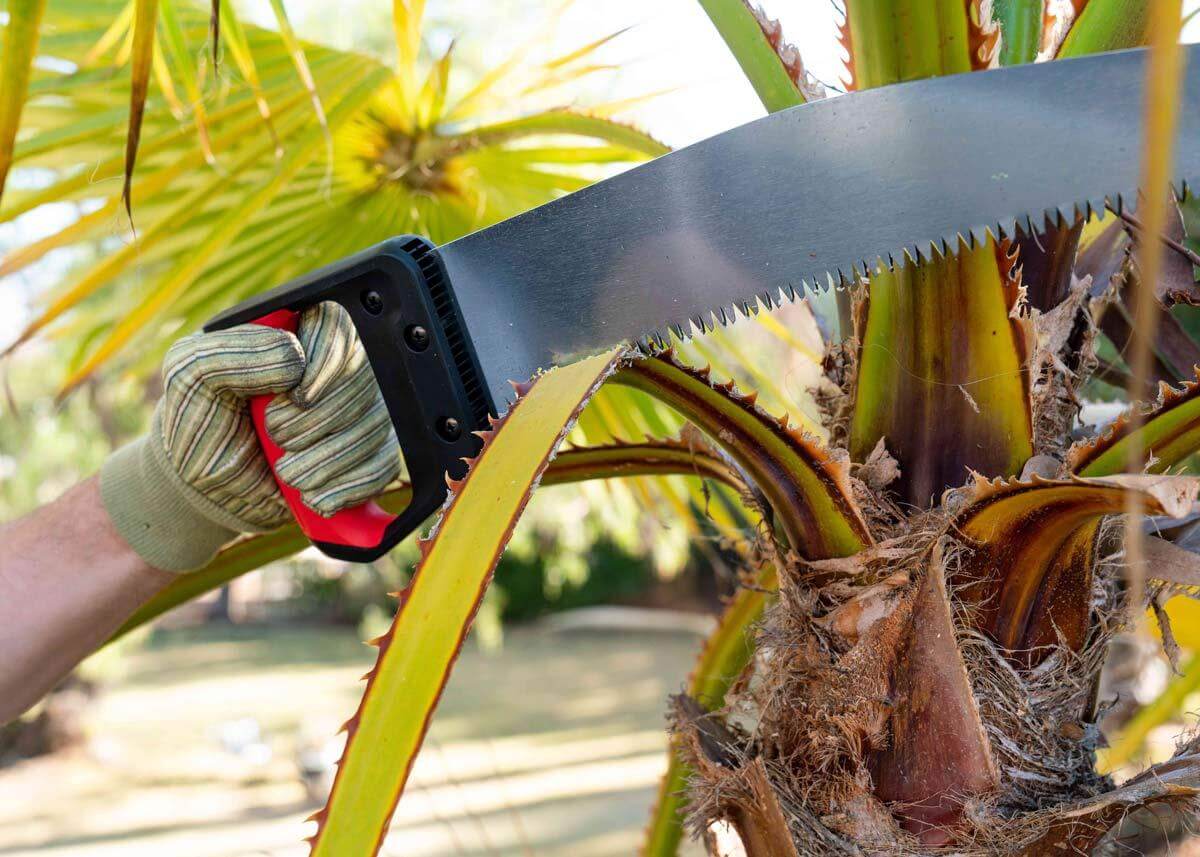
What we cover
ToggleShort Summary
- Palm tree trimming is important for safety, health, and aesthetics.
- Timing pruning correctly in early spring helps maintain the tree’s health while avoiding over-pruning. Choosing the right tools and assessing the condition of a palm tree are essential preparations for successful pruning.
- DIY versus professional trimming should be weighed based on safety, expertise & cost considerations to ensure optimal care of your palm trees.
The Importance of Palm Tree Trimming
It is important to trim palm trees for various reasons, such as safety and tree health, as well as aesthetics. Overgrown or deceased fronds can pose a danger to people and structures. Regular pruning of these trees helps them grow better and prevents conditions like pest infestation and disease from occurring.
There are many advantages of properly tending to palm trees, such as ensuring healthier growth, stopping seeds from dropping each year, and improving their visual appeal.
Safety Concerns
Trimming palm trees can help avert potential safety issues with dead fronds potentially falling and causing harm to passersby. Dead palm fronts are also very flammable, so keeping on top of pruning will mitigate fire risks, especially in regions with prolonged dry spells. By taking out broken, dying, or lifeless foliage regularly, you guarantee your home is a little bit safer.
Tree Health
To ensure a healthy palm tree, proper trimming is essential. It’s important to carefully remove the dead or unhealthy parts of the tree in order for resources to be reallocated toward new growth and greater resilience. Caution should also be taken when pruning so as not to take away any healthy fronds since this can inhibit its food production capabilities and weaken overall structural integrity. By taking into account which portions need removal on an individual basis, you can enable your palm tree’s healthiness.
Curb appeal
Regularly trimming a palm tree to remove dead or withered fronds can really jazz up the front of your home or outdoor entertaining space. The symmetrical look given by regular pruning allows the natural beauty of your particular palm tree to stand out as an eye-catching centerpiece for any landscape design.
Preparing for Palm Tree Pruning
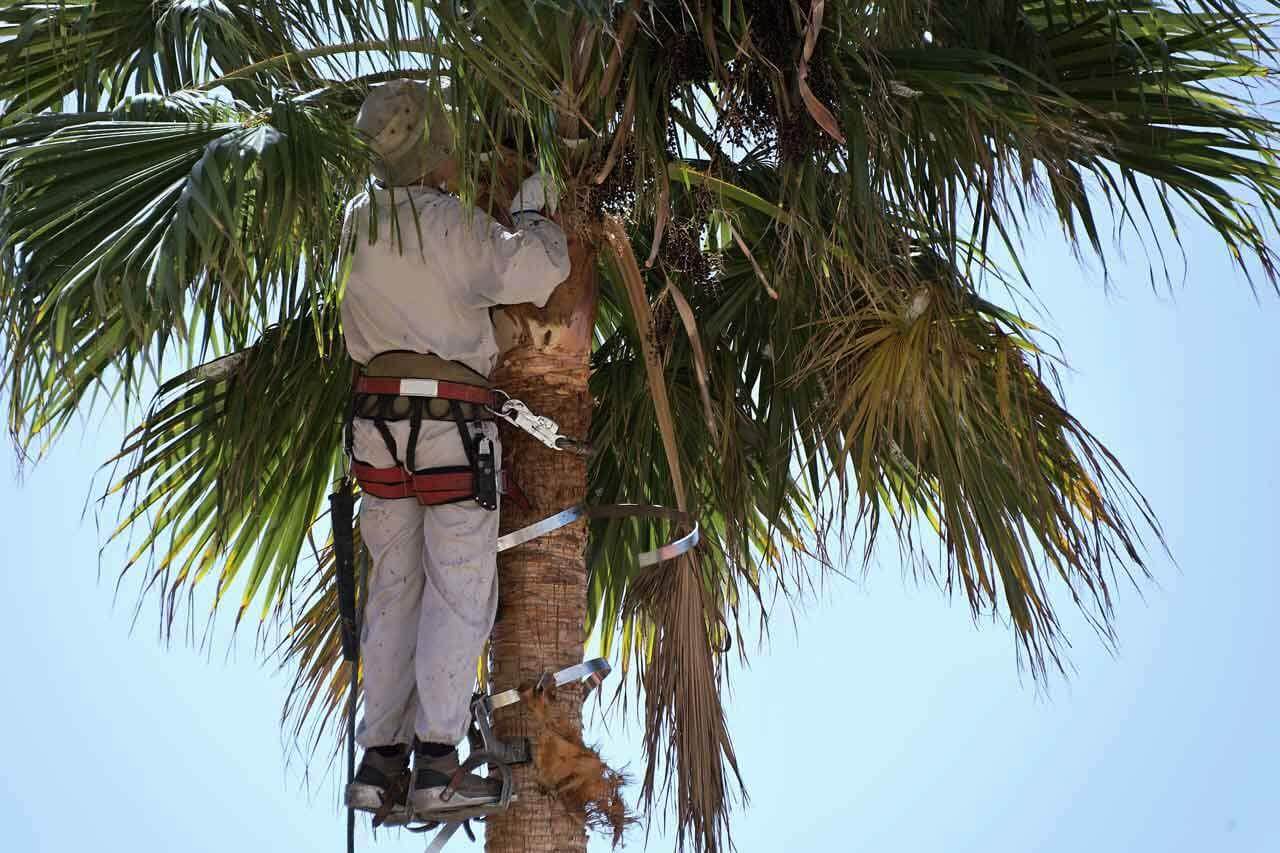
Before beginning to prune a palm tree, it is vital that the right preparations are in place. Determining when would be most suitable for trimming, selecting appropriate equipment, and assessing the overall status of said tree should all take priority before proceeding with cutting back any foliage.
Time of year
The best time for pruning a palm1 tree is during spring. This encourages active growth and helps to reduce the possibility of disease, and doesn’t give seed pods time to open and begin depositing seeds all over your driveway.
Over-pruning can be a concern, so be sure not to remove too much in one go or too regularly can do more damage than good. Don’t trim more often than once per year, and always only trim dead fronds, seed pods, and any green branches below the horizon line.
Choosing the Right Tools
Properly maintaining the correct equipment is essential to achieving great results when pruning a palm tree. Utilizing both a sharpened, sterilized pruning saw and a small chainsaw is the best way to go. It’s important to ensure that all tools used during this process are well-kept so as not to spread any diseases between plants.
Assessing the Tree
When inspecting a palm tree, it’s important to consider which parts need trimming. This can include examining dead or broken fronds as well as discolored ones that might be showing signs of disease. Pruning when the tree begins flowering and fruiting is also beneficial for redirecting resources into its growth and health. Evaluating carefully means you only cut off essential pieces while preserving both the beauty and wellness of your palm tree.
Step-by-Step Guide to Trimming a Palm Tree
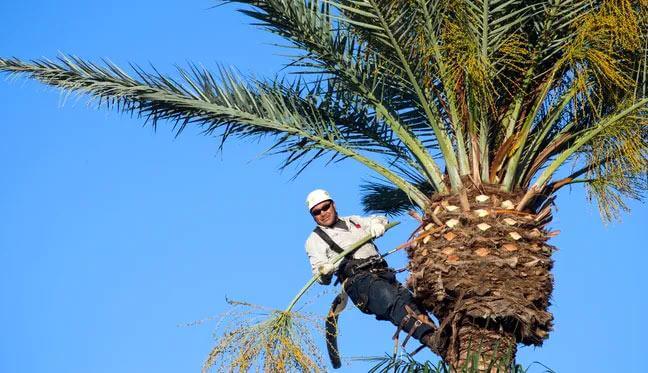
Now that you have the necessary know-how and tools, it’s time to delve into a comprehensive step-by-step tutorial on how best to prune your palm tree without causing any harm. We’ll discuss everything from reaching out for fronds and getting rid of flowers/fruit, all the way up to tidying up after trimming.
We will also cover tasks like removing dying or unwell foliage as well as providing some helpful advice with respect to maintaining your trimmed palm in optimal condition going forward.
Accessing the Fronds
When it comes to trimming a palm tree, having access to the fronds at varying heights is essential. Depending on their size, this may be possible with just an ordinary ladder or even professional assistance from an arborist might be necessary. One should avoid using climbing spikes and cleats as they can cause damage to the trunk of the tree. It’s worth mentioning that working from heights can be extremely dangerous and you should only do so if you are confident you know what you’re doing. If in doubt, call a professional.
Pruning Flowers and Fruit
I suggest you remove any seed pods or flowers from the palm tree when pruning. This will not only stop them from making a mess, but it also allows the tree’s nutrients to be directed toward the growth and overall well-being of the tree. Place your cut 2 inches away from the trunk so no damage occurs when pruning seed pods. Again, be sure your cutting tools are sharp and sterile.
Removing Dead or Unhealthy Fronds
When pruning away dying, dead, or diseased fronds, it is important to cut at least two inches from the trunk so as to not damage the tree and for the purpose of enhancing both plant health and attractiveness.
Cleaning Up After Pruning
After cutting back your palm tree, gather all leaves, fruits, and flowers from the area and discard them into an organic waste bin. Be sure that you stow away any sharp or hazardous elements, such as large barbs from date palms or spines from Cabbage palms. These could harm workers who collect garbage for disposal purposes.
Caring for Your Palm Tree
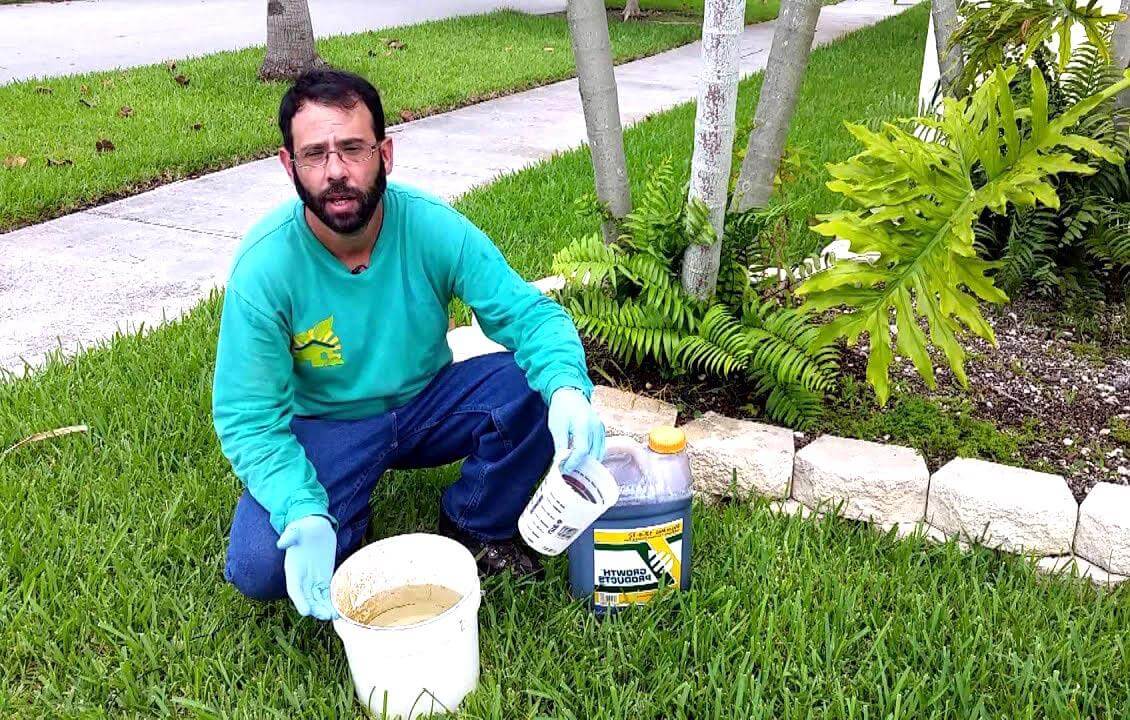
For optimum palm tree care, pruning on a regular basis is necessary. In order to maintain the health and beauty of your tree, fertilizing, and watering should also be included in its maintenance plan.
To ensure that all aspects of upkeep are carried out effectively, it is important for one to take into consideration the trimming requirements along with other critical areas, such as providing adequate fertilizer intake and sufficient hydration levels, which will help protect this unique specimen from any potential dangers or risks posed by inadequate preventative measures.
Regular Pruning
Regular pruning is necessary to maintain the health and good looks of your palm tree, but it’s essential not to overdo it. This should happen once every year or two, with any dead fronds being removed when noticed in the interim.
Maintaining a balance between regular trimming for growth control and allowing natural expansion will result in long-term positive results both aesthetically and nutritionally for these trees.
Fertilizing Your Tree
To make sure your palm tree is able to flourish, fertilization should be given proper attention. Natural sources like compost, bone meal, and rock phosphate are preferable when possible. Yet if these can’t be used, then slow-release options such as Milorganite or complete water-soluble solutions, including 8-2-12 fertilizer, must become the go-to option. For optimum growth during its growing season, it’s recommended that a dosage of fertilizer every 3, to 4 months will do wonders for the health of your beloved tree!
Watering Practices
Watering appropriately is key to keeping a palm tree healthy. When planting a new one, daily hydration should be given for the initial week. When established though, irrigating two or three times weekly except if rain falls suffices. To ensure that your palm remains strong and vigorous, it’s important to retain consistently moist soil in an area where drainage will not be impeded. By heeding these watering rules, you can guarantee the good health of your palm.
DIY vs. Professional Palm Tree Trimming
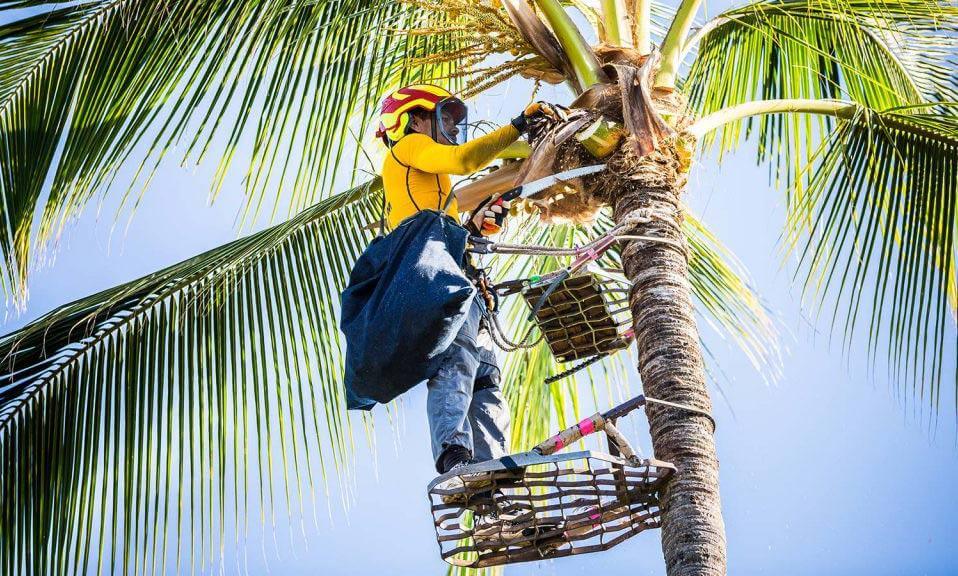
When choosing whether to prune your palm tree yourself or hire a professional, there are several things to consider. Safety, expertise, and experience, as well as cost.
For those looking at doing it themselves, safety should always come first, any tools used need to be handled with caution, especially chainsaws. Working from heights is always dangerous, so be sure to wear a harness. Alternatively, a specialist arborist has been trained for such tasks and their extensive knowledge of proper techniques will ensure you get high-quality results.
Safety Considerations
If cost is a priority when trimming palm trees, it’s important to keep safety risks in mind. Professionals use personal protective equipment PPE and the right tools that DIYers may not be aware of or have access to. Risks include potential falling fronds, electrical dangers, and wildlife. Hiring an expert provides greater assurance of both effectiveness as well as better protection against accidents while pruning your tree safely.
Expertise and Experience
Professional arborists, equipped with the necessary knowledge and proficiency in utilizing pruning tools, are proficient when it comes to properly trimming a palm tree. They possess an expert understanding of how the species grows and develops over time. On top of that, they can carry out safe maintenance without putting themselves or their treasured palm at risk, as homeowners may not have adequate expertise or experience for this work-intensive task.
Hiring professionals is a wise decision that guarantees quality care for your tree while ensuring its safety too!
Cost Factors
For those looking to trim their palm tree, it may be cost-effective to go the DIY route. Extra expenses such as tool and waste removal costs should not be underestimated. Alternatively, professional services could prove pricier but deliver a safer and more efficient result.
At the end of the day, whether one goes for do-it-yourself or specialist help will depend on budget limits, personal preferences, plus other individual conditions that exist at the present time regarding said palm tree or trees in general.
Summary
To keep the beauty and safety of your palm tree in check, proper trimming and upkeep is a must. Whether you opt for self-maintenance or seek professional help, it’s important to have accurate information on hand so that you can ensure its longevity. Following expert tips and techniques as well as having the right tools at your disposal, will allow you to enjoy palm trees now and well into the future.
FAQ's
When pruning a palm tree, it is important to only remove dead or dying fronds and no more than one-third of all green leaves. Stick to cutting fronds below the horizon. Utilizing saws or shears for making what’s known as a “hurricane cut” can be damaging since this approach stresses the tree out while also leaving it open to being susceptible to pests.
The spring months are ideal for trimming your palm trees. This will encourage healthy new growth and also allow you to trim flower stalks as they are growing and before they drop beads and make a mess.
When it comes to trimming a palm tree, the key is not cutting too close. The best way of doing this without risking killing the plant is by using pruning shears or loppers and ensuring you cut no less than two inches away from its trunk. Any dead fronds, dying leaves, or diseased parts should be removed completely so that only 2 inches remain attached to the stem. To avoid damaging your palm tree altogether, do not remove anything beyond what was mentioned above, and steer clear of removing something known as hurricane cuts.
In order to prune a palm tree that is too tall, it is necessary to use a pole saw or hire a pro arborist. They have the proper gear to make short work of tall palm trees.
- University Of Florida, (2020) Pruning Palms. <https://hort.ifas.ufl.edu/woody/pruning-palms.shtml> Accessed: 20-03-2024.












